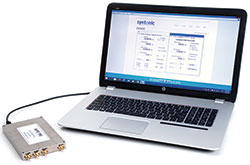
Syntonic Microwave’s RF tuner and IF-to-IF converter product lines require the very best signal sources—beyond what could be found on the market. So Syntonic set out to build the highest performing microwave synthesizer and make it available to the market. The result is the DS-3000 family, comprising the DS-3001 with a temperature compensated crystal oscillator (TCXO) and the DS-3002 with an oven controlled crystal oscillator (OCXO). The compact design continuously tunes from 100 MHz to 20 GHz in 1 Hz steps. Fast tuning is accomplished through high speed internal switching and settling, with tuning via four-wire SPI or USB interfaces. The DS-3000 series provides low cost, signal generator class performance and high-reliability for both commercial and military applications—well-suited for challenging and difficult environments.
Multi-loop synthesis techniques are employed in the microwave frequency plan to give the DDS-based DS-3001 and DS-3002 their excellent phase noise performance, which is also enabled by the high quality, high performance system reference. Excellent spurious suppression is also a natural outcome of Syntonic’s synthesis methodology. The phase noise and spurious performance are consistent with the most demanding test equipment and carrier receiver/transmitter requirements. As shown in Figure 1, the architecture achieves excellent phase noise from near-in to very wide offsets. At 10 GHz, for example, the typical phase noise ranges from −76 dBc/Hz at 100 Hz to −136 dBc/Hz at 10 MHz.
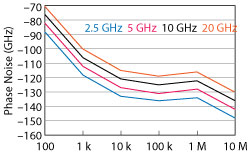
Figure 1 Phase noise performance of the DS-3001.
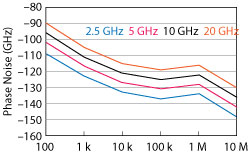
Figure 2 Phase noise performance of the DS-3002.
Users requiring the best in phase noise and frequency stability will find the DS-3002 version of the synthesizer pushes the performance bar to new levels in these two categories. The phase noise of this model is especially improved at the near-in offsets from the carrier, with improvement of greater than 20 dBc/Hz (see Figure 2). At 10 GHz, the typical phase noise ranges from ‐96 dBc/Hz at 100 Hz to ‐136 dBc/Hz at 10 MHz. The DS-3002 is well-suited to applications such as instrumentation and carrier transmission/reception with higher-order modulation signals. The frequency stability of the DS-3002 is also better than that of the standard model, with the stability of the overall output at ± 0.1 ppm over the ‐20°C to +70°C temperature range and less than 1 ppm aging per year.
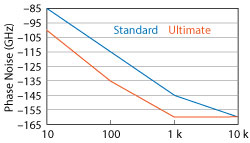
Figure 3 Phase noise of the 100 MHz reference outputs of the DS-3001 and DS-3002.
The high-stability, low noise, accurate system clock provides two separate outputs for synchronizing and daisy-chaining, enabling users to serve both 100 MHz and 10 MHz to downstream and upstream equipment. This provides a fully synchronous component and system profile. Figure 3 shows the phase noise performance of the 100 MHz output for both DS-3000 models. The DS-3002 has better phase noise below 10 kHz offset from the carrier. The internal reference will auto-lock to an external 10 MHz reference when present.
The DS-3000 can be operated from a Windows PC using Syntonic’s graphical user interface (GUI), which is supplied with each purchase (see Figure 4). The GUI gives full control of the synthesizer, including scan, sweep and step. Auto-routines can be executed, and users have a “list mode” for pre-loading up to 5,000 list entries for switching and settling using known frequency steps. List management is handled either directly through the customer interfaces or via an external Excel or CSV file, which is more convenient for long lists.
The synthesizers are biased with 9 to 15 V and typically consume 10 W (DS-3001) and 12 W (DS-3002). Two ports are available for providing bias: a 14 pin multi-connector and a separate DC input. This enables the synthesizer to be quickly powered for benchtop operation, which means that just a DC connection and USB cable are required for instant and complete control. A unique feature of the 14 pin multi-connector is the locking hardware, making the synthesizer suitable for rugged environments with shock and vibration. The size of each synthesizer is 6.5 in × 4 in × 0.7 in.
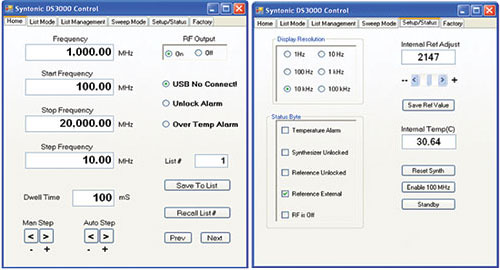
Figure 4 Two of the GUIs used to control the synthesizer.
The experience using both synthesizers has been optimized to match the interface environment expected of today’s microwave signal generators: an executable GUI running on a PC or laptop, a SPI machine interface for embedded applications and hundreds of features baked into the design, which makes the units easy to use.
Formed in 1990 to supply phase-locked oscillators and satellite converters, Syntonic Microwave has developed a strong heritage in the defense market, supplying Lockheed Martin, Northrop Grumman, Raytheon, Harris, Exelis, L3 Communications, DRS and various U.S. government facilities, research institutes and universities.
Syntonic Microwave
Campbell, Calif.
https://www.syntonicmicrowave.com/synthesizers/ds3000-microwave-synthesizer/
